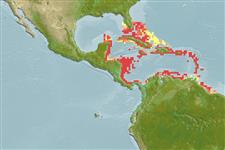Common names from other countries
Environment: milieu / climate zone / depth range / distribution range
Οικολογία
Υφαλόφιλο(α); εύρος βάθους 0 - 23 m (Ref. 83922). Tropical; 28°N - 6°N, 89°W - 55°W (Ref. 4)
Western Atlantic: Caribbean Arc from Cuba to Trinidad, Los Roques.
Length at first maturity / Μέγεθος / Βάρος / Age
Maturity: Lm ? range ? - ? cm Max length : 20.0 cm TL αρσενικό/απροσδιόριστο; (Ref. 271); common length : 15.0 cm TL αρσενικό/απροσδιόριστο; (Ref. 4)
It has lengths of 20 cm, maximum total body length; 15 cm, common length (Ref. 4). Maximum depth range from Ref. 122059. Exclusively inhabits coral reefs (Ref. 106828). Also occurs in shallow waters and inhabits rocky areas, mainly in crevices (Ref. 4), seagrasses and rubble (Ref. 97531). Nocturnal omnivore (Ref. 106982).
Life cycle and mating behavior
Γεννητική Ωρίμανση | Αναπαραγωγή | Γεννοβολία | Αβγά | Γονιμότητα | Προνύμφες
Members of the order Decapoda are mostly gonochoric. Mating behavior: Precopulatory courtship ritual is common (through olfactory and tactile cues); usually indirect sperm transfer.
Holthuis, L.B. 1991. (Ref. 4)
IUCN Red List Status (Ref. 130435)
CITES status (Ref. 108899)
Not Evaluated
Not Evaluated
Human uses
αλιεία: Εμπορικό(ά)
| FishSource |
Εργαλεία
Περισσότερες πληροφορίες
Age/SizeΑύξησηLength-weightLength-lengthΜορφολογίαΠρονύμφεςΑφθονία
Διαδικτυακές πηγές
Estimates based on models
Preferred temperature
(Ref.
115969): 26.7 - 28.3, mean 27.6 (based on 331 cells).
Vulnerability
Low vulnerability (10 of 100).
